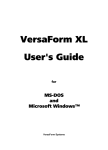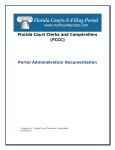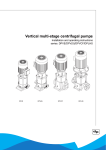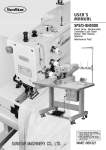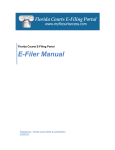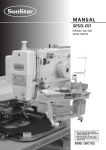Download December 2007 Newsletter
Transcript
General Motors Edition V O LU M E 6 , I SS U E 1 2 Finally, the Launch is Here! D ECEMBER 2 0 0 7 Global Warranty Management will finally launch in the U.S. with Saturn dealerships on Monday, December 3rd, after a more than 2-month delay from the original scheduled target date of September 24th. We have also learned the U.S. launch for “GM proper” dealerships (Chevy, Buick, Pontiac, Cadillac, GMC, HUMMER) has been pushed back (again) from September 2008 to January 2009, although some dealerships will be selected to pilot the program beginning in the first quarter of 2008. The launch delay is apparently tied to compatibility issues with the various Dealership Service Providers (Reynolds & Reynolds, ADP, etc.) and pending lawsuits between GM and Reynolds. Given the DSP delay and the fact that all Saturn stores use ADP computers as their Dealer Management System, however, Saturn dealers will actually have to “piecemeal” some of the process initially. GM released the Global Warranty Management User Manual to Saturn dealerships on November 13th in conjunction with the startup of web-based training for GWM. The manual itself it a mere 129 pages long, but the accompanying “modules,” which detail specific functions within the manual, add up to 589 pages—a considerable read. Training is required for all Fixed Operation Managers, Service Managers, Warranty Administrators, Service Advisors and Parts Personnel. After reviewing the majority of training material, we must agree this training is imperative for every employee in these positions. Some positions will require the completion of one or two modules, while others will require completion of all 13 modules. GM estimates 4 hours to complete all 13 module training sessions. I N T H I S I SS U E Finally, the Launch is Here! GMPP & ESC Shipping Charges 2 Scrapping Parts the Right Way 3 Smart Care Clarifications 3 The Stupid Tire Bulletin 3 The Money Game 4 The Back Page 4 • Although ignored in dealer communications, GM and Reynolds & Reynolds are suing each other over software upgrades to accommodate GWM • Lawsuits could delay GWM launch to “GM proper” dealers even further • Saturn dealers will be forced to “piecemeal” the process for now • Some ADP data fields required for GWM will not be available initially As readers know, we’ve been writing about GWM since 2005. Many of our prior predictions have been confirmed by the GWM Manual such as requirement to list all parts, “real time” processing, more data input areas, new terminology, etc., but we’ve now learned some new information that deserves mention. Labor operations that required an OBDII code as part of the diagnostics will have fields for required input of that information. Major assembly replacement claims (engines and transmissions) will require the input of serial numbers from the new component (you might as well get your techs in the habit of doing this right now). Part warranty claims will require input of the previous RO number (to be called a Job Card Number), date and mileage of the original installation. One of the bigger changes will involve new Authorization Codes available to dealers based on their empowerment level. While Saturn dealers have only used 2 authorization codes over the years and other GM dealers have had 5, the User Manual provides a possibility of 19 different authorization codes, although a Saturn document released on 11/21 only lists 7 dealer-level authorization codes. For each empowerment category, there is yet another “level of empowerment,” represented by a number. 1 is the lowest level and 9 is the highest. In other words, a dealer with a level 6 for Other Labor Hours might be able to claim up to 2.0 hours OLH, while a level 1 might not be able to self-approve any straight time (now called Other Labour Time, and that is not a misspelling). (Continued on page 2) 1-2 PAGE 2 (Continued from page 1) The entire Complaint Code/Failure Code (now called Cause Codes) matrix has been revamped into a 4-digit format, although it seems surprisingly short on description. For example, there is a Complaint Code for “4WD System Warning Light” (0606), but the only other warning light code (0607) is just that: “Other Warning Light Indicated Problem.” V O LU M E 6 , I SS U E 1 2 tion factor would fall by the wayside, it appears they are here to stay. The calculation of warranty expense overall will be reflected based on expense differences for similar repairs to the same platform, called “Vehicle Warranty Groups,” instead of a franchise vs. franchise comparisons as we have now. As an example, brake repairs to a Pontiac G6 will be The use of technician and advisor social security numcompared to other dealers’ brake repairs on the G6, bers during claim input is going away altogether and Malibu and Aura because they will be considered in the instead, they will be assigned a GM identification numsame Vehicle Warranty Group. ber, or GMIN. This should please dealers and compensate for the someIf you think about it though, GM has been preparing times invalid comparisons when a dealer’s expense was dealers for these changes for several years now by resimply a bi-product related to a high volume of sales on a quiring some of this same information to be entered particular model. either in an abbreviated “Failure Code” area, or in the “Comment” section. This is certain to help with the Although we’ve found some punctuation and spelling errors in the new manual, they have been minor. We did transition. note a familiar, if not painful, discrepancy in the time Ironically, the term “Differential Points” is mentioned 5 limit for returning parts to the Warranty Parts Center, times in the new user manual, in particular drilling similar to the one we addressed this past September. down to Differential Points per Vehicle Serviced, or As we all know by now, the time limit to return parts DPVS. requested by the WPC is 21 days (changed from 28-days To our knowledge, this is the first time GM has uttered via bulletin #SOG20060007). Unfortunately, the first the phrase in a dealer-level communication. Even version of the GWM User Manual incorrectly lists the though it is used, in typical GM fashion, there is little time limit as being 28 days. This, however, we’re being information about how the process actually works. Altold, will be “corrected immediately.” though we’d hoped Differential Points as an audit selec- GMPP & ESC Shipping Charges During a recent clinic, an attendee brought up the issue of shipping charges associated with Electronic Service Center components (i.e., radios, CD players, clusters, etc.) in conjunction with a GMPP, SSP, or other non-warranty claims. this as a line-item charge while the other 50% simply add it to the price of the component. The problem is that GMPP has a policy of not paying shipping/freight charges (moreover, this policy relates to overnight part expediting) and invoices that reflected line-item charges for shipping have been reduced by GMPP reps in some cases. up the entire cost by 25%. This means GMPP was paying $4.00—$4.50 more (the 25% mark-up on built-in shipping charges) than they would have intended. So, in essence, it is possible that GMPP may have paid shipping charges for one dealership (since it was built in to To be honest, no one had ever brought this matter to our the price of the component) and not paid them for another attention and we were unaware of the situation. According (if it was billed as a line-item charge). to several attendees though, some ESCs charge shipping, To worsen matters, those dealers who received invoices while others do not. (This is not entirely correct though.) with the shipping charge built-in were most likely marking First, shipping charges for ESC components will generally run between $16 and $18 per component. It stands to reason that the ESC is not going to absorb those charges and will pass them along to the dealership. We have addressed this matter with GMPP and are lobbying for an acceptable solution, which, in our opinion, would be that GMPP should pay the component cost, plus a 25% mark-up and also pay the shipping charge at net cost—after all, this is an unavoidable expense associated with the purchase of these components. What we learned through a few phone calls and emails, however, might come as a surprise. In fact, all nonwarranty ESC component invoices include a shipping charge. The difference is that about 50% of ESCs show As it stands now, GMPP is in the process of confirming our findings and establishing a uniform policy for their field staff and dealers. You should expect a dealer-level communication from GMPP on this issue shortly. Warranty Matters—General Motors Edition PAGE 3 Scrapping Parts The Right Way Based on our field experience, some parts departments use the GM credit memo to scrap parts. This might work if the parts person is familiar with each labor operation and all parts required, but that’s highly unlikely. One of the shortcomings of the GM credit memo is its failure to list all parts associated with a particular labor operation, because they didn’t all have to be listed to get paid. This will be corrected with the GWM system, but hey, that’s more than a year away for most of us. The most efficient means of parts scrapping we’ve seen is to provide a physical copy of the warranty invoice to the parts department. This will insure all the associated parts, and only the associated parts are scrapped. Most systems will allow you to select how many copies of the invoice should be printed. Sometimes we actually see copies being thrown away. Instead, one copy should be considered the “scrapping copy.” It should be placed in a folder with a “scrapping date” (15 days after the claim is acknowledged as paid) and given to the parts department periodically throughout the month as best suits your/their schedule. If there are multiple jobs on the repair order, we suggest holding the scrap copy until all jobs are paid or reconciled. This will avoid the need to make redundant copies of the same invoice. Smart Care Clarifications We’ve become aware that some dealers and even GMPP reps may be confused about the frequency of oil changes allowed with the GMPP Smart Care Program. In some instances, there has been a misconception that Smart Care will only pay for oil changes in coordination with the GM Oil Life System (GMOLS). Meaning, the policy will only pay if the customer’s “Change Oil” light has come on. For clarification, we contacted GMPP’s claim office and were informed that a Smart Care contract does indeed cover up to 4 oil and filter changes a year and up to 2 tire rotations a year. It is in no way tied to the GMOLS. For any of you who may have been told differently by your GMPP rep, just let us know and we will see to it that any misunderstanding is addressed promptly and without fear of retribution. The Stupid Tire Bulletin Subscribers and clinic attendees alike know we are not fans of GM Tire Bulletin #00-03-10-003 that underwent its 13th revision in late October. Besides not addressing the replacement of tires that failed due to another warranted component, it is riddled with incorrect information regarding claim authorization and submission. is scanned by UPS, dealers are authorized to submit the claim. This contradicts the P&P, which states dealers must wait from 5 - 7 days after scanning before submitting the claim. To be sure, dealers should use the UPS website and tracking number from the tire(s) to determine when the tire is received by the manufacturer. Sometimes it is 5 - 7 days, but The bulletin says (in two separate places) that once the tire not always. Only then should you submit the claim for payment and save yourself a lot of rejects. VIP Customer Order Form Warranty Matters would be honored having you as a subscriber. Just $159.95 brings you 12 issues, or $289.95 brings you 24 issues of Warranty Matters GM Edition. Invoiced with receipt of 1st newsletter. Name __________________________________________ Title ___________________________________________ Dealership ______________________________________ Address ________________________________________ City ____________________ State _____ Zip _________ Number of Issues 12-$159.95, or 24-$289.95 4 Ways to Order 5 Fax this page to 901.386.4000 5 Call us at 901.377.6975 5 On-line at warrantymatters.com 5 Mail to Warranty Matters 9110 Valkrie Lane, Suite 100 Lakeland, TN 38002-9228 The Money Game Warranty Matters Warranty Compliance & Consultation 9110 Valkrie Lane, Suite 100 Lakeland, Tennessee 38002-9228 The Warranty Matters™ Newsletter is published 12 times annually. Publisher: Warranty Matters Editor: David Henson Editorial Director: Robin Henson Subscription Rates (U.S. Only): $159.95 1-year (12 Issues) $289.95 2-year (24 Issues) This publication is written to provide accurate and authoritative information about its subject matter and is not intended to render legal advice. If legal advice is needed, you should seek the services of a qualified attorney. © 2007 Warranty Matters All rights reserved. No portion of this newsletter may be reproduced mechanically, electronically or by any other means without the expressed written consent of Warranty Matters. Warranty Matters offers reasonably priced in-house warranty training, audit avoidance, compliance reviews, mail-in mini audits, audit appeals and warranty administration workshops. Contact us today for a no-obligation quote. Contact us: Office: 901.377.6975 Cellular: 901.483.9532 Fax: 901.386.4000 Web: www.warrantymatters.com Email: [email protected] Quite often we’re asked to explain the “Adjusted Cost of Labor Sales,” commonly referred to as “Unapplied Labor” line on the financial statement (page 6, line 30). Oddly enough, we find that many comptrollers don’t even know what this means or how the numbers (if any at all) get there. Sometimes, they will simply remove the money from one of the labor sales accounts (more often, customer pay) and reduce the gross profit margin on that single account, thereby skewing the GP margins and customer pay, or other effective labor rates. First, unapplied labor is a measurement of money paid to a technician but not billed to a repair order. It will usually result in a negative labor adjustment on the financial statement such as: (1,393), including parentheses, and is deducted directly from the total labor gross profit for service and/or body shop sales. The most common causes of unapplied labor are: 1) Paying guarantees to technicians. In other words, if a technician is making $20 per flat rate hour and guaranteed 40 hours a week but only flags (bills) 35 hours, this would result in $100 (5 hours X tech’s pay rate) in unapplied labor. 2) Clock hour technicians also have a cost and the same rule as above is applied. 3) Improper costing from either keypunch errors or passing out raises without a corresponding adjustment in accounting. 4) Paying bonuses for “hours flagged” benchmarks. As an example, a retroactive bonus of $1.00 for every hour flagged after 40 would result in unapplied labor of $145 for a $20 per hour tech who flagged 45 hours ($945 - $800 = $145). After gaining a grasp of unapplied labor, the next question is usually, “What’s the benchmark for unapplied labor?” While in a perfect world the answer would certainly be zero, we don’t work in a perfect world. Given the various dealership accounting methodology we’ve seen, the answer would be: It depends. It depends on your market (union shops, high cost areas, hourly shop, paying guarantees, etc.) and perhaps even how creative your accountant may be. I can hardly forget discussing why CP gross profit margins were low with a comptroller who simply asked, “Well, what would you like them to be?” suggesting he would simply “make adjustments” to reach a goal that would appease the dealer! The Back Page As 2007 draws to a close, I wanted to take time to thank those of you who have continued to share information and remain loyal readers, as well as those of you who have attended our clinics and seminars. In our business, more than any other, the sharing of information is essential and directly tied to how well we can perform our jobs. We’ve had a great time with the GM clinics this year. Not only is it a superb source of information (and newsletter articles) for us, but it’s always fun to listen to the humorous stories that we can all relate to. Throughout the past 13 years, we’ve had the good fortune to work with some of the industry’s best managers and warranty administrators and this year has been no different. Still though, I must admire those who are just beginning their careers in this business and are anxious to learn everything they can, as quickly as they can! With any luck, they will continue to learn for many years to come, just like the veterans before them. I’ve already heard some long-time warranty administrators talking about retiring with the coming of Global Warranty Management. I remember hearing the same thing from technicians when fuel injection was first introduced… Two things that have remained constant in this business: change is inevitable and it’s a tough job even when everything is going right! We wish you all a Merry Christmas and Happy New Year. Dave & Robin




